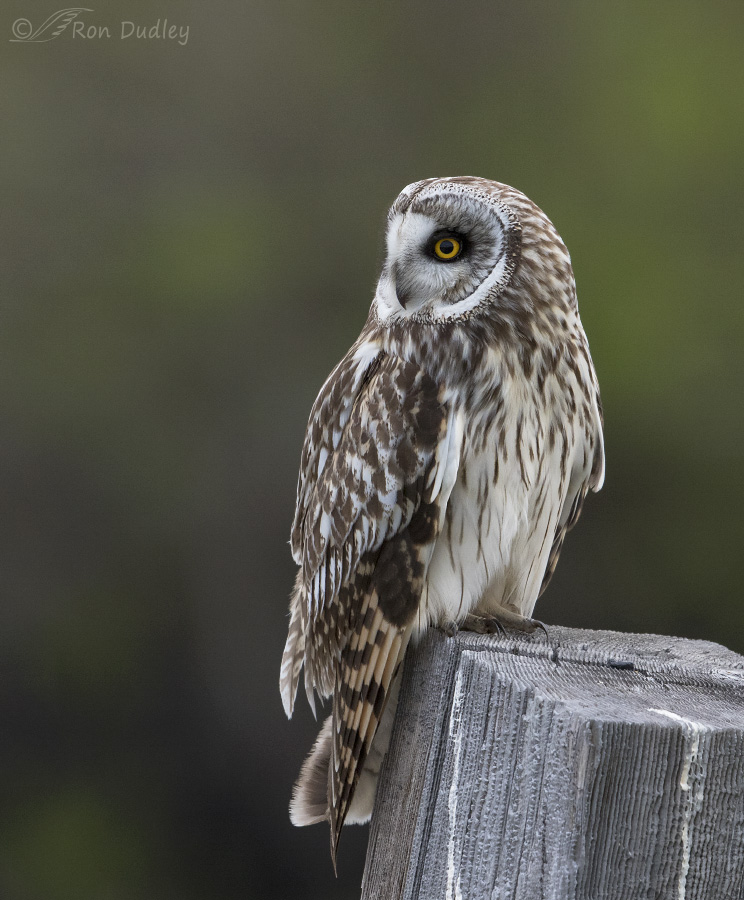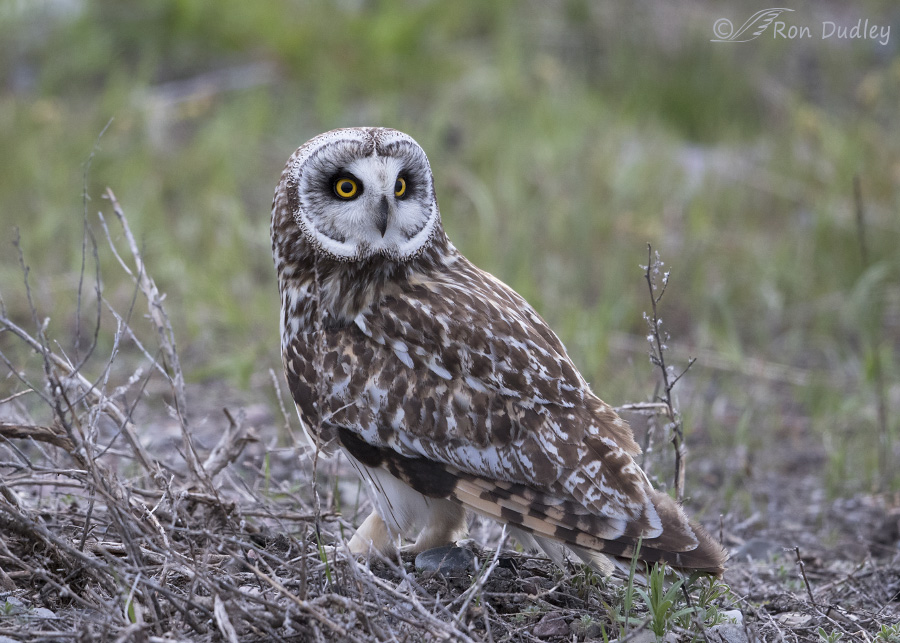I may have never photographed a Short-eared Owl in light more dim than this so I’m surprised to have ended up liking these photos very much.
1/400, f/9, ISO 800, Canon 7D Mark II, Canon EF 500mm f/4L IS II USM, not baited, set up or called in
We found this male Short-eared Owl hunting from a large wooden post on June 2, 2016. Technically we were in Idaho but it was only about a mile from the Montana border.
It was just after dawn with a heavy overcast so as you can see from my image techs the light was abysmal. I deliberately underexposed this shot to get just a bit more shutter speed.
He was calm and accepting of my presence, probably at least in part because of the very low light, and he spent most of his time scanning the nearby grasses and brush for prey. I love the detail here, including but not limited to the “fringing” on the feathers behind the tip of the right wing. That fringing is largely responsible for the “silent flight” of owls.
1/640, f/6.3, ISO 800, Canon 7D Mark II, Canon EF 500mm f/4L IS II USM, not baited, set up or called in
Eventually he flew down and pounced on a nearby brush pile – obviously after prey he’d seen but he came up empty. He stayed here for a while and then flew a few feet further away and continued to hunt. At that point I left him in pursuit of better light and other birds.
While I was taking these shots I remember thinking I’d probably delete them all because of the extremely poor light. I couldn’t have been more wrong.
Ron




Ron – both are great photos, but that first one…WOW!! Glamour portrait with creamy goodness bokeh. Question please – With light being an issue, why shoot that first photo at F/9? My though would be to have shot this wide open or maybe f/5.6 if wide isn’t the sharpest.
Zaphir – I had plenty of time to take many images of this bird and I was quite close to it. More shutter speed without enough DOF to get the entire bird sharp wasn’t my goal. I wanted the tail sharp too. So I went with f/9 and took lots of shots figuring at least one of them would be sharp throughout even at that slow shutter speed. And it worked.
But I also took other shots at different apertures just in case…
Thank you for letting me know what was in your mind. It helps me grow knowing what others were thinking and why. That tail certainly is sharp.
Beautiful bird, and excellent shots!
Such beautiful shots. I’m glad you were not disappointed with them. Such a beautiful bird. Love your insights, always!
No way could I be disappointed with that first shot, Alice. Thank you.
Wonderful shots Ron! Thanks for sharing!
Charlotte
Thanks, Charlotte.
Ron, you ROCK, too! Your photography always makes me smile and gives me joy. Thank you!
These are gorgeous shots! Just gorgeous!
I very much appreciate the kind words, Laura.
What a wonderful experience for you, and for us. I am so very glad that the photographs exceeded your picky expectations. And very glad that despite those expectations you persevered.
Thanks very much, EC.
In response to what Louise said–A young Lakota friend and I were walking along a path in the woods. I told him. “I wish I could find an owl feather someday”. I had told him about an owl I had raised but never had a feather from. Just then Bill said, “Look!” Right in front of me, a large, single, beautiful feather was floating down. landing gently on the shelf-like branches of a small evergreen. It was obviously an owl feather. We looked each other in surprise then laughed about my wish being answered so quickly. I marvelled at its softeness and velvety texture. It was a magical moment…one of many spent with Bill (a very special person who died far too young of cancer)…
I can see why you remember that experience, Patty. Pretty special!
Sometimes we are truly blessed.
Ron,
These are exceptional photographs, detail is amazing and low light or not you captured the owl!
Thanks very much, Ted.
I know you said the fringes on the edges of the primaries are ‘largely responsible’ for silent flight, but there are lots of places where they ascribe silent flight totally to those fringes. And that’s not the case. Experiments have been done with barn owls where they trimmed those fringes off and the birds could still fly perfectly silently. It’s the overall softness and the velvety texture on the feathers that enable silent flight – by, I assume, breaking up the air as it flows over the wing. I’ve been slapped in the face by a falcon flapping its wings – and the feathers are so rigid, it stings! But an owl flapping on my glove and hitting my face is like a caress. Even an isolated, dropped feather is easily distinguishable as that of an owl because of the surface texture and softness. Clearly the fringed edge helps but the edges of the feathers are not as sharp, overall. Owls can’t fly fast, like falcons, and they have a tendency to get wet more as the feathers don’t zip up quite as tightly, but the advantage of silent flight when you are hunting by ear surpasses its disadvantages. Sorry if that was obvious, but I felt compelled to point that out as I’ve heard people so often say it was just the fringes!
Very interesting!!! Thanks for the education…I have been one of those, erroneously, telling others that the silent flight was due to the fringed feathers (but must admit that I’ve always wondered if there was more to it)…
Silent flight IS partially due to fringing, Patty – but as Louise mentions it’s only part of the story.
Louise, I deliberately am not “one of those places” claiming that silent flight is due only to fringing (as you pointed out). I guess it’s a matter of degree as to how much. Perhaps I should have said “partly responsible” instead of “largely responsible.
Louise, I’m always delighted when you chime in on a post. As I’ve said SO many times, YOU ROCK! And I feel so blessed to know you!
I need to get in touch with you about a Mariah issue. I’ll message you now.
Sometimes when I am out walking near dusk or in low light Nature gifts me a sight of such evocative beauty time stands still. Your first image is just such a moment. You have taken my breath away. Thank you so much.
I’m delighted you like it that much, Victoria. Thank you.
Isn’t it great that you can still allow yourself to be surprised ? I think that first low-light image is one of my very favorites of yours……..thanks for the inspiration on open-mindedness !
I learn new stuff every day, Kris. And sometimes surprises can be pleasant ones, even in bird photography…
Two beautiful images of one of my favorite owls!!! Be sure you mount your owl on a weathered wood stump, Dick…and send me pictures. Insaw some of your woork a whilecago, and was VERY impressed…you’re darned good!!!
Thank you Patty, I am giving this project some serious thought. Ron’s picture is simply gorgeous!
Beautiful photographs! Thanks again.
Geeeez, I now have to carve this owl it is so beautiful! That first picture is exceptional from a carvers point of view, but I specifically like the second because it shows habitat and has a frontal face view. I think the colors stand out! Great shots Ron, I’m also glad you changed your mind and prevented the delete mantra from taking over!
I’d like to see that owl if you were to carve it, Dick.
So would I!
Simply stunning images, Ron.
Thank you, Dan.
That first shot is exceptionally beautiful. I like the weathered post and the soft greens in the background. Like Nancy said, the owl really pops! I’m glad this series survived that brutal “delete” trigger of yours. (I tease. I tease.)
(I tease. I tease.)
I get a lot of teasing here on that issue, Marty. Probably rightfully so…
Beautiful! The low light for these evening/night hunters is a challenge. “Chimping” has never worked for me! May be “short ear” but looks like “no ear” Glad you took the photos and figured out the setting that would work……….
Glad you took the photos and figured out the setting that would work……….
Judy, I’ve never chimped since memory cards became so large that saving card space isn’t an issue. Didn’t do it much before then either.
The owl really pops in the very low light. The detail of the entire bird at f/9 is amazing! Love!
Thank you, Nancy.
Thanks for pointing out the fringes. Very helpful to explain silent flight to visitors at the nature center here. Diana
Glad it was useful to you, Diana. Keep in mind that fringing is only one of their adaptations for silent flight.
Be slow to delete…. Personally I love the soft light… ;-)))
Yup, that’s why I NEVER “chimp” in the field.
What does “chimp” mean???
It means to delete photos from your camera (memory card) in the field after only looking at them on the camera screen.
I ‘m sure glad to hear you don’t “chimp” in the field…you’re dangerous enough once home!!! Maybe if we gave you a banana, you’d chimp a little less at home….just wondering…….
I hate bananas. Probably been 30 years since I’ve eaten (part of) one.